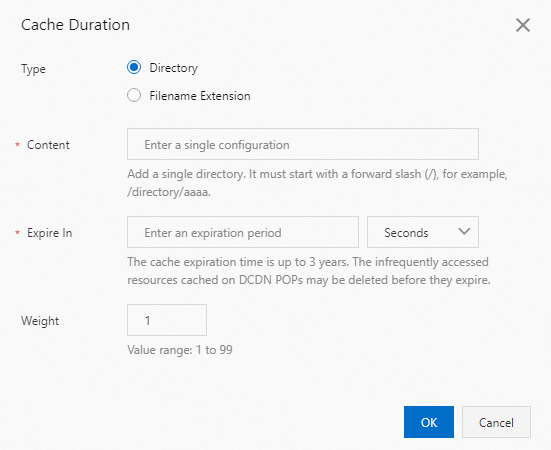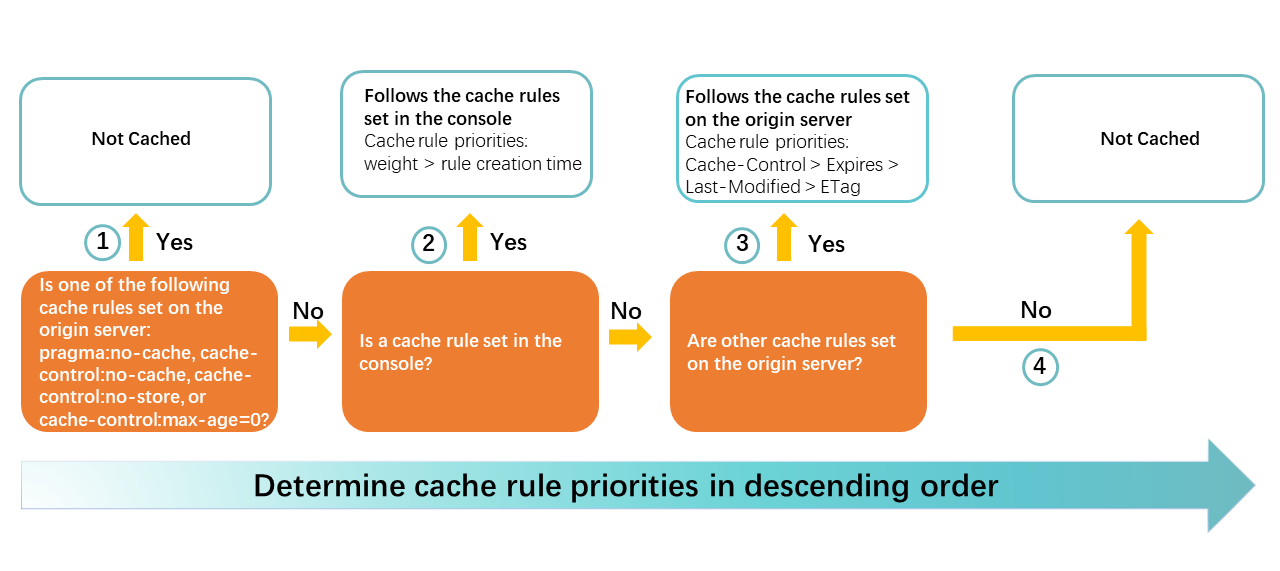Time-to-live (TTL) is the amount of time that a resource is cached on Dynamic Content Delivery Network (DCDN) points of presence (POPs). When the TTL of a cached resource ends, the resource on the POPs expires. Requests that attempt to access expired resources are redirected to the origin server. The retrieved resources are returned to the clients and cached on the POPs. You can create a cache rule for static resources based on file directories or file name extensions.
Usage notes
After you add a domain name, you can modify the TTL value. The amount of origin traffic and the fees incurred vary based on the TTL that you specify. The resource TTL affects the origin fetch frequency. Specify a TTL based on your business requirements.
A short TTL may cause frequent origin fetches and increase loads on the origin server. A long TTL may cause resources on the POPs to become outdated.
If a resource that is cached on a POP is infrequently accessed, the resource may be overwritten by frequently accessed resources on the POP before the resource expires.
For information about cache rules for static files and which rule is executed, see Default cache rule and priorities of cache rules. For information about cache rules for dynamic files, see Overview.
When you update a file on the origin server, we recommend that you add a version number to the file name to differentiate file versions after updates.
This way, each version of the file after an update has a unique name. For example, you can name a file img-v1.0.jpg before the file is updated and img-v2.1.jpg after the file is updated.
Procedure
Log on to the DCDN console.
In the left-side navigation pane, click Domain Names.
On the Domain Names page, find the domain name that you want to manage and click Configure.
In the left-side navigation tree of the domain name, click Caching.
On the Cache Duration tab, click Add.
In the Cache Duration dialog box, configure the parameters according to the following table.

Parameter
Description
Type
Select Directory or Filename Extension.
Directory: adds a cache rule for resources in the same directory.
Filename Extension: adds a cache rule for resources that have the same file name extension.
Content
Specify the directory or filename extension for which you want to add the cache rule.
If you select Directory, take note of the following rules:
You can enter only one directory at a time. You can use a forward slash (/) to specify all directories.
You can enter a full path. The path must start with a forward slash (/). Example: /directory/aaa.
If you select Filename Extension, take note of the following rules:
You can enter one or more filename extensions. Separate the filename extensions with commas (,). Example:
jpg,txt. Filename extensions are case-sensitive.The following types of static files are supported:
Images: GIF, PNG, BMP, JPEG, and JPG.
Web pages: HTML, HTM, and SHTML.
Audio and video files: MP3, WMA, FLV, MP4, WMV, OGG, and AVI.
Text files: DOC, DOCX, XLS, XLSX, PPT, PPTX, TXT, and PDF.
Others: ZIP, EXE, TAT, ICO, CSS, JS, SWF, APK, M3U8, TS, EJS, SVG, WOFF, and OTF.
You cannot use the asterisk wildcard character (*) to specify all file types.
Expire In
Specify the TTL. The maximum TTL is three years. Take note of the following rules:
Specify a TTL of one month or longer for static files that are infrequently updated, such as images and application packages.
Specify a TTL for static files that are frequently updated, such as JavaScript and CSS files, based on your business requirements.
Specify a TTL of 0 seconds to disable caching for dynamic files, such as PHP, JSP, and ASP files.
Weight
Specify a weight for the cache rule. The weight indicates the priority of the cache rule. Valid values: 1 to 99. A larger value specifies a higher priority.
NoteIf you create multiple cache rules, we recommend that you specify a unique weight for each cache rule to define their priorities.
Cache rules that have the same weight are prioritized based on the creation time, regardless of the rule type. The rule that has the earliest creation time takes precedence.
If you have configured multiple cache rules for a cached resource, only the first matched rule takes effect.
Click OK.
You can modify or delete the cache rule that you created on the Cache Duration tab.
Default cache rule and priorities of cache rules
After a POP retrieves a static file from an origin server, the POP processes the static file based on the priorities of the following cache rules. A smaller number specifies a higher priority.
If the response carries the
pragma:no-cache,cache-control:no-cache,cache-control:no-store, orcache-control:max-age=0directive, the static file is not cached.DCDN follows the TTL for cached resources, or the TTL for HTTP status codes that are configured in the console.
NoteIf a request matches multiple cache rules, only one rule takes effect based on the following order of priority: weight > creation time.
If you create multiple cache rules, we recommend that you specify a unique weight for each cache rule to define the priorities of the cache rules. A higher weight specifies a higher priority.
Cache rules that have the same weight are prioritized based on the creation time, regardless of the rule type. The rule that has the earliest creation time takes precedence.
Alibaba Cloud CDN follows other cache rules set on the origin server. Headers in responses from the origin server are in the following descending order of priority:
Cache-Control>Expires>Last-Modified>ETag.The response carries the
Cache-Controlheader, and the directive ismax-ageors-maxage, which is set to a value that is greater than 0, such as Cache-Control:max-age=3600. If both themax-ageands-maxagedirectives exist, the value of thes-maxagedirective prevails.The response carries the
Expiresheader, such as Expires:Tue, 25 Nov 2031 17:25:43 GMT.If the response carries the
ETagorLast-modifiedheader, the TTL is calculated based on the following rules:If the response carries the
Last-Modifiedheader, TTL = (Current time -Last-Modified) × 0.1. If the result is from 10 seconds to 3,600 seconds, the result applies. If the result is less than 10 seconds, the TTL is 10 seconds. If the result is greater than 3,600 seconds, the TTL is 3,600 seconds.If the response carries only the
ETagheader, the TTL is 10 seconds.
If the response does not carry the
ETag,Last-Modified,Cache-Control, orExpiresheader, the static file is not cached on the POP.
HTTP caching mechanisms
HTTP provides three types of headers that can be used to control caching behavior.
Configuration examples
Example 1: If you want POPs to cache .txt files for 7 days, add a cache rule for .txt files in the DCDN console and set the TTL to 7 days.
Example 2: The following cache rules are set for the accelerated domain name demo.aliyun.com. When DCDN POPs retrieve the resource http://demo.aliyun.com/image/example.png, the two rules are matched. In addition, the rules have the same weight. In this case, the rules are prioritized in order of creation time. The rule with the earliest creation time has the higher priority. Therefore, the rule that is set for the /image directory is applied because the rule is created the earliest.